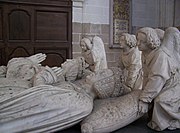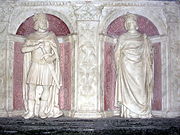
The Albert Memorial, directly north of the Royal Albert Hall in Kensington Gardens, London, was commissioned by Queen Victoria in memory of her beloved husband Prince Albert, who died in 1861. Designed by Sir George Gilbert Scott in the Gothic Revival style, it takes the form of an ornate canopy or pavilion 176 feet (54 m) tall, in the style of a Gothic ciborium over the high altar of a church, sheltering a statue of the prince facing south. It took over ten years to complete, the £120,000 cost met by public subscription.
The Venerable often shortened to Venerable is a style, title, or epithet used in some Christian churches. The holy person that is titled "the venerable" is often accorded by their spiritual perfection and wisdom.

Peter II (1418–1457), was Duke of Brittany, Count of Montfort and titular earl of Richmond, from 1450 to his death. He was son of Duke John VI and Joan of France, and a younger brother of Francis I.

Francis II was Duke of Brittany from 1458 to his death. He was the grandson of John IV, Duke of Brittany. A recurring theme in Francis' life would be his quest to maintain the quasi-independence of Brittany from France. As such, his reign was characterized by conflicts with King Louis XI of France and with his daughter, Anne of France, who served as regent during the minority of her brother, King Charles VIII. The armed and unarmed conflicts from 1465 to 1477 and 1484–1488 have been called the "War of the Public Weal" and the Mad War, respectively.
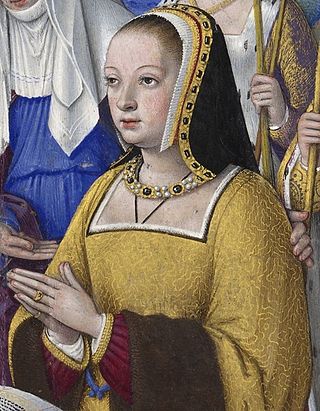
Anne of Brittany was reigning Duchess of Brittany from 1488 until her death, and Queen of France from 1491 to 1498 and from 1499 to her death. She was the only woman to have been queen consort of France twice. During the Italian Wars, Anne also became Queen of Naples, from 1501 to 1504, and Duchess of Milan, in 1499–1500 and from 1500 to 1512.
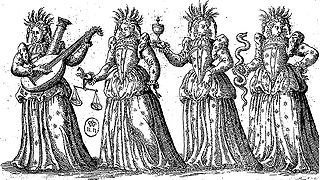
The cardinal virtues are four virtues of mind and character in classical philosophy. They are prudence, justice, fortitude, and temperance. They form a virtue theory of ethics. The term cardinal comes from the Latin cardo (hinge); these four virtues are called "cardinal" because all other virtues fall under them and hinge upon them.

The seven gifts of the Holy Spirit are an enumeration of seven spiritual gifts first found in the book of Isaiah, and much commented upon by patristic authors. They are: wisdom, understanding, counsel, fortitude, knowledge, piety, and fear of the Lord.

Françoise de Foix, Comtesse de Châteaubriant was a chief mistress of Francis I of France.

Gaston IV was the sovereign Viscount of Béarn and the Count of Foix and Bigorre in France from 1436 to 1472. He also held the viscounties of Marsan, Castelbon, Nébouzan, Villemeur and Lautrec and was, by virtue of the county of Foix, co-prince of Andorra. From 1447 he was also Viscount of Narbonne. Through his marriage to Eleanor, heiress of the Kingdom of Navarre, he also held the title of Prince of Navarre.

Michel Colombe was a French sculptor whose work bridged the late Gothic and Renaissance styles.
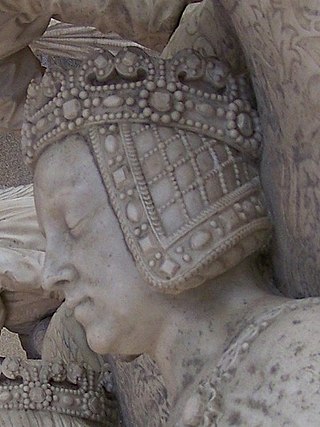
Margaret of Foix was Duchess of Brittany from 1474 to 1487 by marriage to Duke Francis II.

Saint Paul Aurelian Cathedral was a Roman Catholic cathedral, now basilica, in Saint-Pol-de-Léon, in the Finistère department in Brittany in north-western France. The 13th-century church stands on the site of the original church founded by Saint Paul Aurélien in the 6th century. It is a listed monument since 1840.

Margaret of Brittany was the elder of the two daughters of Francis I, Duke of Brittany and duchess consort of Brittany.

The Cardinal and Theological Virtues is a lunette fresco by Raphael found on the south wall of the Stanza della Segnatura in the Apostolic Palace of the Vatican. Three of the cardinal virtues are personified as statuesque women seated in a bucolic landscape, and the theological virtues are depicted by putti.

Anne of Brittany was the object of representations very early on. The royal propaganda of Charles VIII and, later on, of Louis XII idealized her as a symbol of the perfect queen, on the union between the kingdom and the duchy, and of the return to peace. Maximilian's Austria having been evicted from the marriage, had a different perspective on the events. Throughout the centuries, historians and popular imagery forged a very different Anne of Brittany, attributing her physical or psychological characteristics or actions that are not necessarily verifiable through historical data.

The Hours of Margaret of Foix is an illuminated book of Hours, named after its patron, Margaret of Foix. It follows the Paris liturgy and was produced in France between 1471 and 1486. Many of the prayers included in this manuscript focus on childbirth, motherhood, and producing a male heir. The illuminations include scenes from the Passion of Christ and Christ's birth. It is now part of the Salting Collection in the Victoria and Albert Museum in London.

Pierre Le Baud or Lebaud was a French clergyman and historian known for his writings on the history of Brittany.
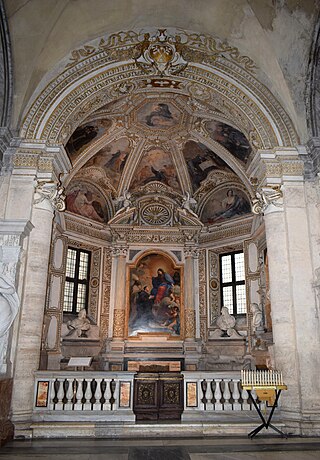
The Mellini or Saint Nicholas of Tolentino Chapel is the third chapel on the left-hand side of the nave in the Church of Santa Maria del Popolo in Rome. The chapel contains several funeral monuments of the members of the Mellini family among them the works of Alessandro Algardi and Pierre-Étienne Monnot.

The Tomb of Louis XII and Anne of Brittany is a large and complex silver-gilt and marble sculptured 16th century funerary monument. Its design and build are usually attributed to the Juste brothers although the work of several other hands can be distinguished. Designed for and installed at the Saint-Denis Basilica, France, it was commissioned in 1515 in memory of Louis XII and his queen Anne of Brittany, probably by Louis' successor Francis I, and after years of design and intensive building was unveiled in 1531.

The Carmelite convent at Nantes was a convent of the Carmelite Order established in 1318 in Nantes, France, then situated within the Duchy of Brittany. The convent was gradually destroyed beginning with the French Revolution.









